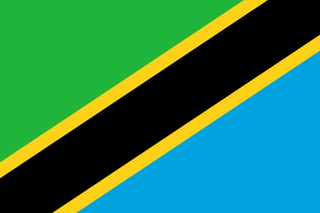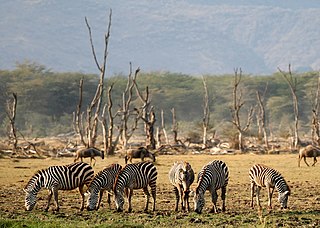The Tanzania Conservation Resource Centre (CRC) is a non-profit educational and research-support organization based in Arusha, Tanzania. Founded in 2006, the Centre has a small library of primarily conservation materials (both electronic and in print) and provides services for visiting researchers and local students.

Arusha is a city in north eastern Tanzania and the capital of the Arusha Region, with a population of 416,442 plus 323,198 in the surrounding Arusha District. Located below Mount Meru on the eastern edge of the eastern branch of the Great Rift Valley, Arusha has a temperate climate. The city is close to the Serengeti National Park, the Ngorongoro Conservation Area, Lake Manyara National Park, Olduvai Gorge, Tarangire National Park, Mount Kilimanjaro, and Arusha National Park on Mount Meru.

Tanzania, officially the United Republic of Tanzania, is a country in eastern Africa within the African Great Lakes region. It borders Uganda to the north; Kenya to the northeast; Comoro Islands at the Indian Ocean to the east; Mozambique and Malawi to the south; Zambia to the southwest; and Rwanda, Burundi, and the Democratic Republic of the Congo to the west. Mount Kilimanjaro, Africa's highest mountain, is in north-eastern Tanzania.
CRC has operated for over five years in Tanzania, supporting conservation and wildlife research through capacity-building and networking for local and foreign researchers and students. The Centre has an office near the Njiro cinema complex in Arusha, and provides logistical, informational and networking support.
The CRC provides a way for students to connect with researchers and their projects, and provides a database of both projects and of students seeking positions.

Maasai Mara National Reserve is a large game reserve in Narok County, Kenya, contiguous with the Serengeti National Park in Mara Region, Tanzania. It is named in honor of the Maasai people and their description of the area when looked at from afar: "Mara," which is Maa for "spotted," an apt description for the circles of trees, scrub, savanna, and cloud shadows that mark the area.
Transport in Tanzania includes road, rail, air and maritime networks. The road network is 86,472 kilometres (53,731 mi) long, of which 12,786 kilometres (7,945 mi) is classified as trunk road and 21,105 kilometres (13,114 mi) as regional road. The rail network consists of 3,682 kilometres (2,288 mi) of track. Commuter rail service is in Dar es Salaam only. There are 28 airports, with Julius Nyerere International being the largest and the busiest. Ferries connect Mainland Tanzania with the islands of Zanzibar. Several other ferries are active on the countries' rivers and lakes.

Moshi is a Tanzanian municipality with a population of 201,150 according to the National Bureau of Statistics (Tanzania) estimates. The municipality is in the Kilimanjaro Region and is situated on the lower slopes of Mount Kilimanjaro, a dormant volcano that is the highest mountain in Africa. The municipality covers about 59 square kilometres (23 sq mi) and is the smallest municipality in Tanzania by area.

Arusha Region is one of Tanzania's 31 administrative regions. Its capital and largest city is the city of Arusha. The region is bordered by Kajiado County and Narok County in Kenya to the north, the Kilimanjaro Region to the east, the Manyara and Singida regions to the south, and the Mara and Simiyu regions to the west. Major towns include Monduli, Namanga, Longido, and Loliondo to the north, Mto wa Mbu and Karatu to the west, and Usa River to the east. The region is comparable in size to the combined land and water areas of the United States state of Maryland.

Korogwe is a town in Tanzania, with a population of 44,000 in 2002. It is the main centre of Korogwe District, which is within the Tanga Region.

Lake Manyara National Park is a Tanzanian national park located both in Arusha Region and Manyara Region, Tanzania. The two administrative regions have no jurisdiction over the parks. The park is governed by the Tanzania National Parks Authority. The majority of the land area of the park is a narrow strip running between the Gregory Rift wall to the west and Lake Manyara, an alkaline or soda-lake, to the east.
Usa River is a town around 23 kilometres (14 mi) to the east of the City of Arusha, the capital of the Arusha Region of northern Tanzania. Usa River is the district capital of Meru District.

The School of St Jude is a charity-funded school located in the city of Arusha, in the northern Arusha Region of Tanzania.
Conservation in Uganda is the protection and sustainable use of the country's rich natural resources. It became a significant movement during the British colonial period in the early 20th century and continues to play a major role in Uganda's political economy, as it underpins the tourist industry accounting for a fifth of the country's exports.
Kisongo is an administrative ward in the Arumeru district of the Arusha Region of Tanzania. According to the 2002 census, the ward has a total population of 7,501. It is located in the outskirts of Arusha, about 7 km west of Arusha Airport.
Kimandolu is an administrative ward in the Arusha District of the Arusha Region of Tanzania. It is roughly 6 km from the centre of Arusha town and lies between the Old Moshi Road and the Arusha-Himo highway, which leads directly to Moshi and Kilimanjaro International Airport. There are various charitable NGOs currently working in the area with schools, healthcare and sports, such as Art In Tanzania. The local representative is Jackson Lemunga.
AfricAid is a 501(c)(3) nonprofit organization that supports girls’ education in Tanzania in order to provide young women with the opportunity to transform their own lives and the futures of their communities. It was founded in 2001 by Ashley Shuyler, who had traveled to Tanzania in 1996 and witnessed the country’s enormous educational needs while there.

Water supply and sanitation in Tanzania is characterised by: decreasing access to at least basic water sources in the 2000s, steady access to some form of sanitation, intermittent water supply and generally low quality of service. Many utilities are barely able to cover their operation and maintenance costs through revenues due to low tariffs and poor efficiency. There are significant regional differences and the best performing utilities are Arusha and Tanga.

Frankfurt Zoological Society (FZS) is an international conservation organisation founded in 1858 with headquarters in Frankfurt am Main, Germany. FZS focuses on maintaining biodiversity and conserving wildlife and ecosystems in protected areas and outstanding wild places. FZS leads and supports about 30 projects in 18 countries.
Bernhard Grzimek, renowned German zoo director, zoologist, book author, editor, and animal conservationist in postwar West-Germany, served as president of the Frankfurt Zoological Society for over forty years.
The Foundation for Technical Education (FTE) is a philanthropic organization based in Geneva, Switzerland that provides the tools and skills needed for young people to achieve successful careers in the technical field.

Lazaro Samuel Nyalandu is a Tanzanian politician, former member of the Chama Cha Mapinduzi and former Minister of Natural Resources and Tourism. He represented the Singida North constituency in the National Assembly since 2000.. He is currently a member of CHADEMA, an opposition party in Tanzania.

Nelson Mandela African Institution of Science and Technology (NM-AIST) is a public institution in northern Tanzania based in Arusha City.
The Nelson Mandela African Institution of Science and Technology in Arusha is one in the network of Pan-African Institutes of Science and Technology located across the continent.
The NM-AIST Arusha, which is accredited by Tanzania Commission for Universities (TCU) is being developed into a research intensive institution for postgraduate and postdoctoral studies and research in Science Engineering and Technology (SET). The training in SET, however, incorporates appreciable doses of relevant humanities and business studies ingredients. Life sciences and bio-engineering is being developed to become one of the niche areas of the NM-AIST Arusha, taking advantage of the immense bio-diversity in the region. The institution thus, seeks to stimulate, catalyze and promote intensification of agricultural production, and value addition to the various natural products produced in Tanzania and the Eastern African region. Other main thematic areas to be covered by NM AIST-Arusha include Energy, ICT, Mining, Environment and Water.
Emusoi Centre is a centre for young Maasai women in Arusha, Tanzania. Founded in 1999, it is run by Sr. Mary Vertucci, a Maryknoll Sister, with a staff of Tanzanians.
As of 2015, the Centre provides a home for 50 young women who are in the pre-secondary program at the Centre and a few other girls taking classes in Arusha town. The Centre also supports close to 300 other Maasai girls who are in boarding school.









